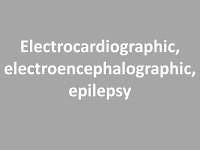Changes on electroencephalography (EEG) and electrocardiography (ECG) may occur in epileptic patients (EPs) both during epileptic seizures and in the interictal period. An abnormal EEG is not surprising in EPs. However, an abnormal ECG trace requires the exclusion of heart disease and verification of the diagnosis of epilepsy. ECG changes could also be explained by the influence of epileptic discharges on the central autonomic nervous system, the effect of antiepileptic drugs (AEDs) and the presence of genetically determined disorders of ion channel function [1–7]. Detection of ECG changes is also important because of the phenomenon of sudden unexpected death in epilepsy (SUDEP) [2].
The aim of our study was to assess the occurrence of changes on EEG and ECG in EPs. Twenty-two non-treated patients (NTPs) with newly diagnosed epilepsy before the inclusion of AEDs (mean age: 36.1 ±12.1 years) and 28 patients with epilepsy treated with AEDs (TPs) for at least 2 years (mean age: 29.6 ±8.7 years) were enrolled in the study. Subjects with cardiovascular disease, accompanying metabolic and/or electrolyte disturbances, alcohol abuse, and those on medications other than AEDs were excluded from the study.
The following tests were used in the statistical analysis: χ2, Shapiro- Wilk, Student’s t-test, ANOVA, Mann-Whitney U test and Kruskal-Wallis test.
On the routine EEG, paroxysmal changes were observed in 12 NTPs (54.55%) and 14 TPs (50%); on the 24-hour EEG in 14 NTPs (63.64%) and 19 TPs (67.86%). The analysis showed a significantly higher value of 24-hour EEG for the detection of abnormal seizure activity (p = 0.02). Paroxysmal EEG changes were related to a higher number of seizures over the last month and treatment with carbamazepine (p = 0.05).
On the resting ECG, changes were recorded in 10 NTPs (45.45%) and 11 TPs (39.29%). The following were observed: significant J-point elevation (n = 9; 18%), bradycardia (n = 5; 10%), RBBB (n = 4; 8%), shortening of QTc (n = 3; 6%), QTc prolongation (n = 1; 2%), LGL syndrome (n = 1; 2%), AV block Iº (n = 1; 2%), LBBB (n = 1; 2%) and SVEs (n = 1; 2%). In all NTPs with bradycardia (22.7%) paroxysmal EEG changes were recorded.
Changes on the 24-hour ECG were more frequent in NTPs than TPs, which did not confirm the adverse effect of AEDs on ECG as reported by many authors. The following were present: VEs (n = 28; 56%), SVEs (n = 23; 46%), bradycardia (n = 13; 26%), tachycardia (n = 9; 18%), pairs/triplets (n = 3; 6%), bigeminy (n = 3; 6%), trigeminy (n = 2; 4%), AV block IIº (n = 2; 4%) and pause (n = 1; 2%).
On the 24-hour ECG changes were more frequent in male than female patients (46.43% vs. 10.71%; p = 0.04), which is significant in connection with the reports of a higher risk of SUDEP in males [2]. The type of AEDs (including CBZ) did not have a significant influence on the ECG trace. However, we observed a relationship between ECG changes and the number of AEDs taken. An abnormal ECG was recorded in 1 patient in the monotherapy subgroup and in 10 patients in the polytherapy subgroup (p = 0.05). As reported in the literature, polytherapy increases the risk of arrhythmia [7].
In NTPs and TPs with an abnormal routine ECG, paroxysmal changes in the 24-hour EEG were slightly more frequent (63.64% vs. 36.36% and 39.29% vs. 21.43%, respectively). Simultaneous changes in the 24-hour EEG/ECG monitoring were recorded in 2 NTPs and 2 TPs. In NTPs, bradycardia was observed in one patient during paroxysmal changes and in the other patient a pause was noted several minutes earlier before the recorded EEG changes. In TPs, bradycardia was observed in one patient (on CBZ) and tachycardia was noted in another patient (on VPA and LEV) also at the time of paroxysmal EEG changes.
In conclusion, our study confirmed that 24-hour EEG and ECG monitoring is much more useful in the detection of changes in the electrophysiological activity of the brain and the heart. NTPs are significantly more frequently exposed to the risk of cardiac abnormalities.
We consider that in order to provide accurate diagnosis of epilepsy it is necessary to perform both neurological and cardiological examination including the electrophysiological assessment. Because of the risk of SUDEP, ECG changes should never be ignored, however slight and seemingly insignificant they may appear.



